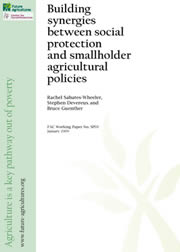By Rachel Sabates Wheeler, Stephen Devereux and Bruce Guenther
January 2009
 The paper explores how social protection and agricultural policies interact, creating either synergies or conflicts between them. To the extent that social protection measures help poor rural people expand their assets, use them more efficiently and adopt higher return activities,there should be strong synergies with agricultural development. Reverse synergies can also arise,if agricultural policies help farmers improve their livelihoods and reduce their vulnerability.
The paper explores how social protection and agricultural policies interact, creating either synergies or conflicts between them. To the extent that social protection measures help poor rural people expand their assets, use them more efficiently and adopt higher return activities,there should be strong synergies with agricultural development. Reverse synergies can also arise,if agricultural policies help farmers improve their livelihoods and reduce their vulnerability.
But conflicts can occur if policy objectives are inconsistent with each other, and these are alsoexamined in this paper. We draw on numerous examples from the across the globe, but withspecific emphasis from the African continent to highlight issues including, liquidity constraints,scale and threshold effects, timing, seasonality and policy complementarities. In conclusionwe consider lessons for how the agricultural policies and social protection instruments can bedesigned and implemented to exploit welfare and growth synergies.
After a lengthy period of relative neglect, agriculture is back on the policy agenda of many African governments and international agencies. Smallholder farming is recognised by the Commission for Africa, NEPAD and others as central to rural livelihoods and therefore indispensable to food security and poverty reduction and the achievement of the Millennium Development Goals (MDGs) in Africa. At the same time, however, the multiple risks and vulnerabilities that smallholders face are increasingly well understood, and new policy frameworks are emerging that distinguish between different types and sources of risk (for example, idiosyncratic and covariant risk affecting agricultural production, markets and health) and between different response options (investment in crop or livestock protection, irrigation, market stabilisation and access, cash transfers, and so on).
Reducing risk in smallholder farming requires agricultural development policies, and policies that create a conducive enabling environment for agriculture, while managing risk in smallholder farming requires social protection policies that can also contribute to reducing risk. The paper analyses how social protection and agricultural policies interact, creating either synergies or conflicts between them.
We explore both current and potential synergies and conflicts between ‘welfare-promoting’ and ‘growth-promoting’ forms of social protection and agricultural development. To the extent that social protection measures help poor rural people expand their assets, use them more efficiently and adopt higher return activities, there should be strong synergies with agricultural development. Reverse synergies can also arise, if agricultural policies help farmers improve their livelihoods and reduce their vulnerability. But conflicts can occur if policy objectives are inconsistent with each other, and these are also examined in this paper.
{jathumbnail off}{jcomments off}
